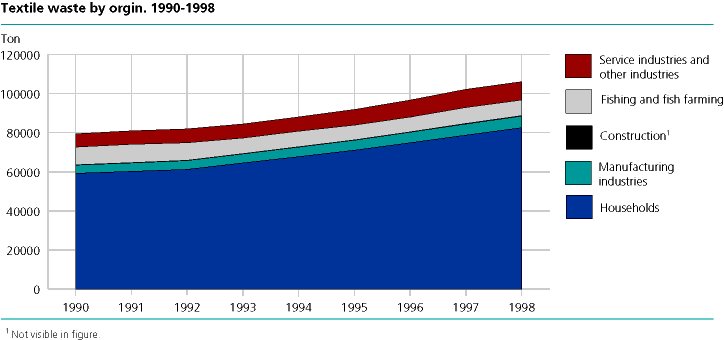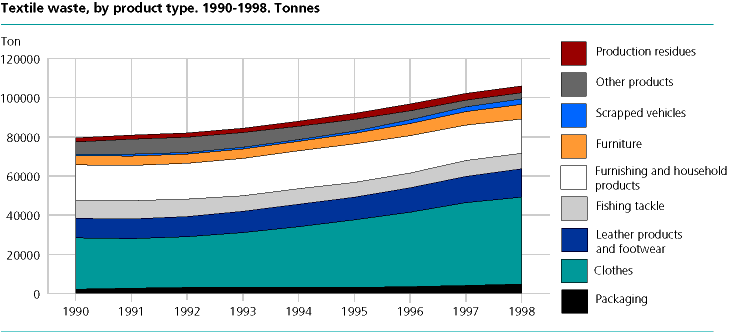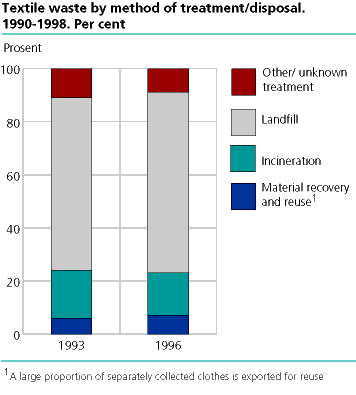Content
Published:
Norwegians throw away more clothing
A steadily increasing share of textile waste stems from households. An increasing share of textile waste consists of clothing. In 1998, 106 000 tonnes of textile waste occurred in Norway. By comparison, Norwegians generated in total around 6.5 million tonnes of waste the same year. The amount of textile waste in Norway has increased throughout the 1990s.
In 1998, nearly 80 per cent of textile waste came from households, with clothing making up 40 per cent of the total amount. 72 per cent of the waste landed in dumps in 1998. The corresponding percentage in 1992 was 79.
Textiles cover natural or synthetic fibres and various mixtures of these, as well as products made of such fibres. Raw materials are for example wool, cotton, silk, linen, cellulose and oil. The manufacture of textiles is a resource-intensive process and generates emissions to air and water. Increased reuse and recycling of textile waste, which today ends up in the dump, could reduce energy consumption and pollution.
Most from households
The main source of textile waste is households, which contributed 83 000 tonnes or 78 per cent in 1998. The primary household textile waste is clothing. Manufacturing accounted for six per cent, fishing, whaling and aquaculture for seven per cent and the rest of the industries, of which service industries make up the majority, accounted for nine per cent of the total amount of textile waste in 1998. The trend is that the households' total amounts of waste and also the share of textile waste have increased steadily, while the manufacturing and service industries' share has fallen. This is connected with the increased share of clothing in textile waste. The construction industry generates little textile waste. The figures are uncertain, particularly in the case of service industries.
We throw more clothes
If we look at the type of products that result in textile waste, clothing made up the largest share, accounting for 42 per cent in 1998. The clothing figures show a steady increase during the period, from about 34 800 tonnes in 1991 to 47 200 tonnes in 1998. Clothing, leather products and footwear made up 56 per cent of the amount of waste. The consumption expenditure statistics show that the households' annual spending to clothing increased in the mid 1980s and mid 1990s, but was relatively stable around 1980 and 1990. The increased spending to clothing partly explains the increasing amounts of textile waste, but it also seems that we throw away clothes more quickly now than in former years.
Seventeen per cent of the textile waste in 1998 was made up of interior decorating textiles such as wall coverings, carpets, curtains and the like. Other products contain inter alia technical textiles and treated textile products such as tents and camping equipment, parasols, umbrellas and awnings. Like interior decorating textiles, these declined in 1990-1998, from 8 per cent in 1990 to three per cent in 1998. With respect to technical textiles, the decline is probably connected to the decline in textile industry output during the same period. There was also a small percentage of packaging, accounting for 4.3 per cent of the total amount of textile waste in 1998.
Most ends up in landfills
More than 70 per cent of the textile waste in Norway ends up in landfills. The share of textile waste ending up in landfills has, however, decreased from 79 per cent in 1992. Twenty per cent was incinerated in 1998. Only eight per cent of the total amount was recycled or reused. This is substantially more than the two per cent recycling in 1992, though. In every year in the time period, about twenty per cent has been incinerated. This suggests that in the case of textiles, recycling reduces landfilling rather than incineration.
A large share of what was collected for recycling or reuse was exported to countries in the Third World and Eastern Europe as development aid. A small portion was recycled or sold through various enterprises such as the Salvation Armys Fretex companies, UFF and jumble sales. There have been discussions on whether clothing collected for reuse should be counted or not as waste. It has nevertheless been included in these statistics.
Revised figures
This is a revised version of waste accounts for textiles, originally released December 12. 2000. In the accounts, two different methodologies are employed: Calculation of supply of goods from manufacturing and external trade statistics and compilation of waste statistics. The results from these two methodologies differ substantially for the early 1990s but converge towards 1998. Originally it was evaluated that the supply of goods, which indicate relatively stable waste generation throughout the period, gave the most reliable figures. A closer scrutiny forced a revision of this, and it is now considered that the waste statistics are more appropriate. Hence a substantial growth in textile waste generation is indicated.
The statistics is published with Waste accounts.
Contact
-
Statistics Norway's Information Centre
E-mail: informasjon@ssb.no
tel.: (+47) 21 09 46 42



